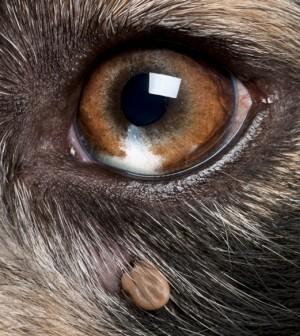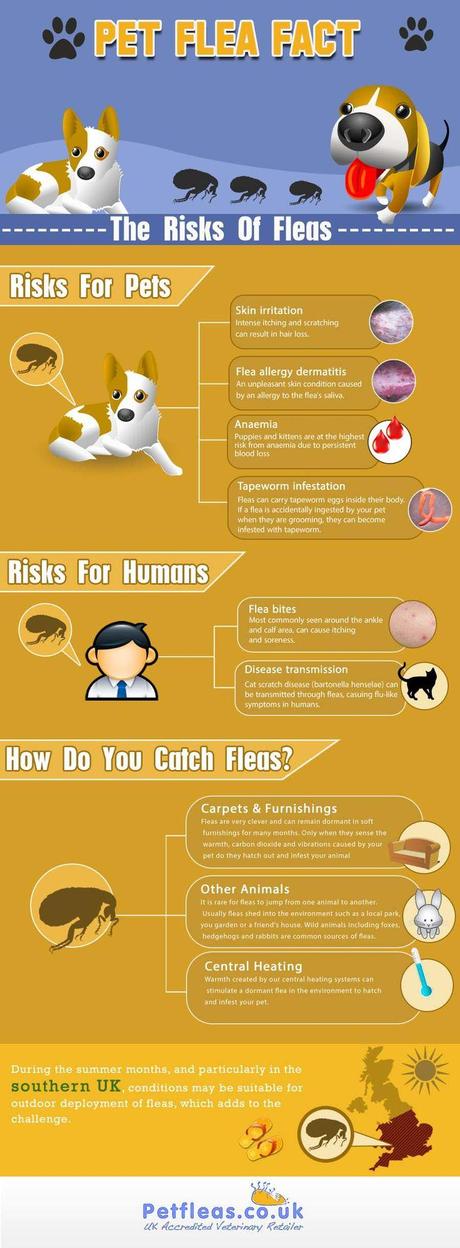
Even the most well-groomed dog is susceptible to infestation by various skin parasites, some of which are potential carriers of serious diseases. All-year round prevention is the key to controlling these pests.
(Check out Keeping Canine Cooties to a Minimum)
Fleas
You need to take all-year round preventive action against fleas. Running a flea comb through your dog’s coat, especially over the rump, may catch fleas, which you can kill by squashing them against the teeth of the comb with a finger. You are more likely to find flea dirts, which show up as black debris. Treatment includes spot-on products – applied at the back of the neck – tablets, and collars. Alternatively, you can spray, wash or powder your dog. Treat all other pets, including cats and rabbits, at the same time as your dog. Fleas pass most of their life cycle in carpets and furniture, so you may need to use separate products to eradicate them from the home.
Ticks
These unpleasant creatures are a seasonal problem that mostly occurs in spring and autumn. Ticks can attach themselves to your dog and may transmit diseases; for instance, some ticks carry the bacterium “Borrelia burgdogferi,” acquired from mammals such as rodents and deer, which causes Lyme disease in humans and dogs.
Swift removal of a tick reduces the risk of infections. Using tweezers or a tick hook, hold the tick close to the dog’s skin but without squeezing its body. Gently twist to remove it. If the head is embedded try to remove that too. Mouthparts left behind can cause a reaction and a lump may develop but treatment is not usually needed and the lump will vanish.
If you live in or are traveling to an area known for ticks, you should take preventive measures such as spot-on treatments and collars.
Mites
The spider-like “Sarcoptes” mite is commonly passed on to dogs from foxes. It particularly affects the ears, elbows, and hocks, causing sarcoptic mange with intense itchiness, hair loos, and skin sores.
“Demodex” mites are probably passed from mother to puppies at birth. They affect the skin on the head and around the eye, and can appear elsewhere, causing fur thinning, bald areas, and a musty smell. These mites may be found in skin scraping from healthy dogs but they particularly occur at times of stress and illness when a dog’s immune system is weakened. Mild demodectic mange revolves without treatment. Severe cases need specific treatment to kill mites, which is continued until several skin scrapings are clear; antibiotics may also be needed if there is an associated skin infection.
The bright orange, non-parasitic harvest mite is picked up by a dog running in fields in summer. It tends to be found on the skin of the toes, ears, and around the eyes. Harvest mites rub off easily and usually cause no reaction, but they may be linked to a serious disorder called seasonal canine illness.
Lice
A dog who has lice will scratch frequently. The lice can be seen in the coat and on the skin, with nits (eggs) attached to hairs. The entire life cycle of a louse takes place on an individual dog and lasts less than three weeks. Lice are transferred by close contact to other dogs or via grooming tools, but not to people. Your vet will recommend specific treatments.

The Risk of Fleas *
Signs of a Problem
- Scratching
- Bare patches where hair falls out
- May be scabs and crusting
- May see the actual parasite
- Black debris (flea dirts, which leave tell-tale red streaks when dissolved in water)
- Effects of disease caused by parasite (ex. in Lyme disease carried by ticks: painful, swollen joints, fever, failure to eat, lethargy, swollen nymph glands; more rarely, neck pain, seizures, kidney failure, heart problems).

